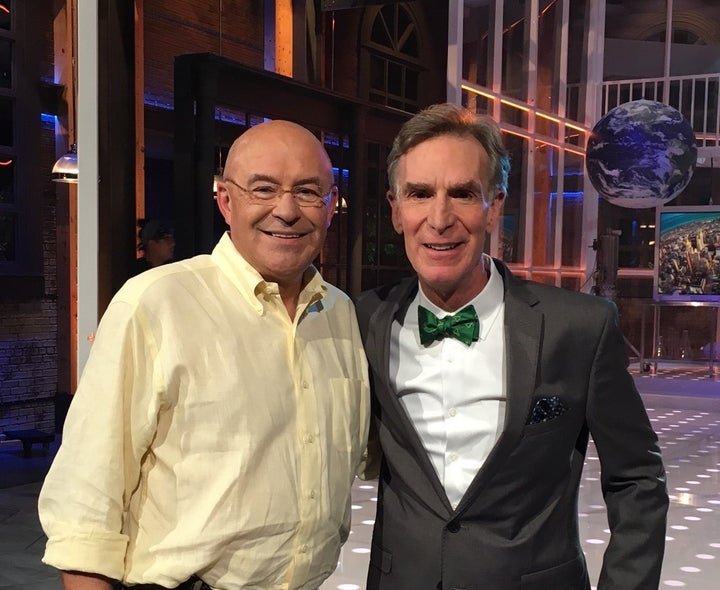
Left to right: Robb Fraley, Julie Kenney, Fred Gould, Bill Nye
Recently, I’ve written about how fake news and deceptive publishing practices are making it difficult for consumers to distinguish fact from fiction when it comes to science. This issue is always top of mind for me, because whenever I speak at conferences or talk to reporters, I am inevitably asked at least one question about false claims, “internet myths,” and even retracted “scientific” studies regarding GMOs. Even if a claim has been debunked for years, it tends to periodically resurface on social media because it is presented to look like real news. Most people don’t know the difference between organizations like the National Academy of Sciences and the Union of Concerned Scientists, so how would they know who to trust as a source for unbiased scientific analysis?
If you were born in the 1980s or early 1990s, you were fortunate to live in an era before social media could spread bad science – and you were also fortunate to have “Bill Nye the Science Guy” as a trusted scientific source.
From 1993 to 1998, Bill Nye made science accessible and exciting for elementary-aged Millennials with his educational TV program, “Bill Nye the Science Guy.” He used fun and easy-to-understand experiments, humor and music to explain complex-sounding concepts like “Inertia is a property of matter.” He taught them that “Science rules!” Teachers everywhere started using Bill’s show to supplement their science lessons and, more than 20 years later, many still show the episodes today.
That’s why I was so excited when I found out that Bill was creating a new show for Netflix called “Bill Nye Saves the World.” The 13-episode series, which was released on April 21, tackles the most debated scientific issues facing us today, including vaccinations, climate change, and of course, GMOs. Bill wants to break down the myths that can ultimately hinder scientific progress and hurt society. This time, the show is geared toward adults – which I think is fantastic! Bill is a trusted source of scientific information for so many; when he speaks, I believe people listen – especially the now-grown Millennials who have already learned so much from Bill over the years.

I too have learned a lot from Bill over the past few years. While I’m proud to call him a friend today, I wasn’t sure how things were going to go when I first met him at an Intelligence2 Debate about genetically modified food back in 2014. I was one of the debaters and Bill was in the audience. At the time, Bill had recently published his book, “Undeniable: Evolution and the Science of Creation,” in which he included a chapter that expressed concerns about the long-term environmental impacts of GMOs (or GM foods, as he called them). During the debate, Bill asked a question that again indicated his skepticism of the technology. Afterward, I told him that if he really wanted to understand the science behind GMOs, he should come visit me at our Monsanto facility in St. Louis, see how the research is done, and ask all the questions he wanted. A couple months later, I was shocked when Bill actually took me up on the offer!
He showed up by himself, armed with tough questions and a desire to learn, and we spent a whole day together talking to scientists, visiting labs and greenhouses, and taking a deep dive into everything from genotyping and genetic modification to what happens during the years each product spends in safety testing and regulatory review. I explained why we believe GMOs are a vital tool for improving food security and reducing agriculture’s impact on the environment, especially as we face the challenges of climate change and a rapidly growing world population. And most importantly, my colleagues and I showed Bill the hard data – the methodically researched, peer-reviewed evidence that has been generated from more than 1,000 independent studies – something any “science guy” should appreciate.
A few weeks later, I learned that Bill had changed his mind about GMOs. Not only that, but he was going to rewrite the GM foods chapter of his book for a new edition, which was published later that year. With his characteristic enthusiasm, Bill not only announced this during an interview, he announced it by declaring, “When you’re in love, you want to tell the world!”
Once again, I was shocked. It is very rare for someone to change their mind about something they feel strongly about; most people tend to assign more weight to evidence that confirms what they already believe and disregard anything to the contrary – a phenomenon called confirmation bias. However, keeping tradition with some of history’s most renowned scientific leaders, Bill demonstrated that he truly is a “Science Guy” we can all learn from. And I have Bill to thank for teaching me these important lessons:
- When you’re not sure if you fully understand a topic you feel strongly about – and are able to recognize that you may be basing your opinion on ideology rather than data – it’s important to push yourself out of your comfort zone to research and learn more.
- Watch for inconsistencies in your own criteria for judging different scientific topics. In Bill’s case, he could no longer rationalize accepting the scientific consensus concerning climate change and evolution, but disregarding it with respect to GMOs.
- When new evidence tells you that you’d been wrong, you admit it. For science to move ahead, it’s critical that the people who pursue it be willing to recognize and correct their mistakes. And this takes great courage. When Bill announced he’d shifted his position on GMOs, he immediately came under fire with attacks on everything from his reasoning to his credentials; some of his critics even alleged that my company, Monsanto, paid him off. Of course, we knew this wasn’t true – and Bill could’ve avoided the controversy by not saying anything – but helping other people understand the science was more important to him than anything else.
- And that takes me back to where I started – and the most valuable lesson I’ve learned from Bill – which is how crucial it is to be able to communicate about science in a way that people can understand and care about. Once upon a time, most scientists – including myself – didn’t recognize the importance of explaining our research outside the scientific community. In retrospect, if we had done a better job of helping consumers understand GMOs from the beginning, we probably would have avoided most of the confusion that still exists today.
Data-driven scientists aren’t always the best communicators, which makes it even more important to have mainstream science advocates like Bill and astrophysicist Neil Degrasse Tyson. These guys are incredibly gifted at getting people excited about science and helping them understand new technology that makes our world better. And they aren’t just telling you how they feel; they’re presenting the verifiable evidence.
